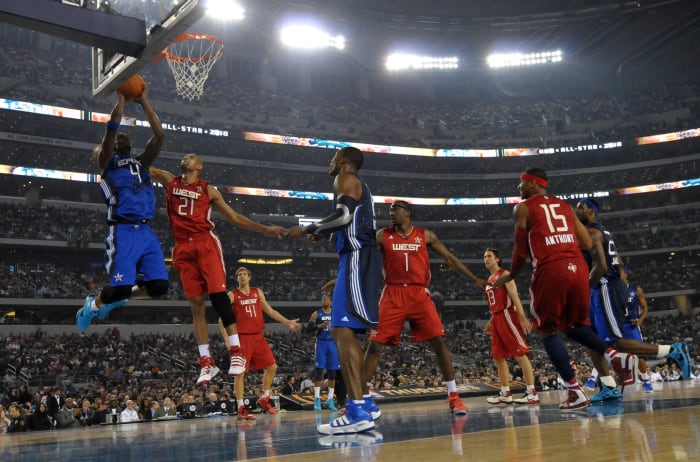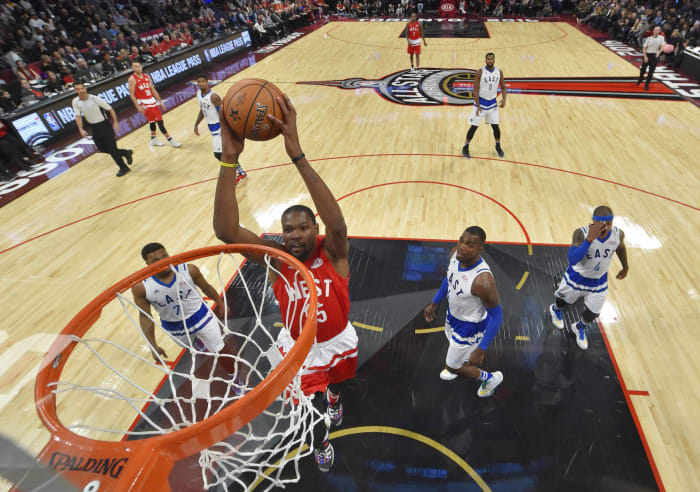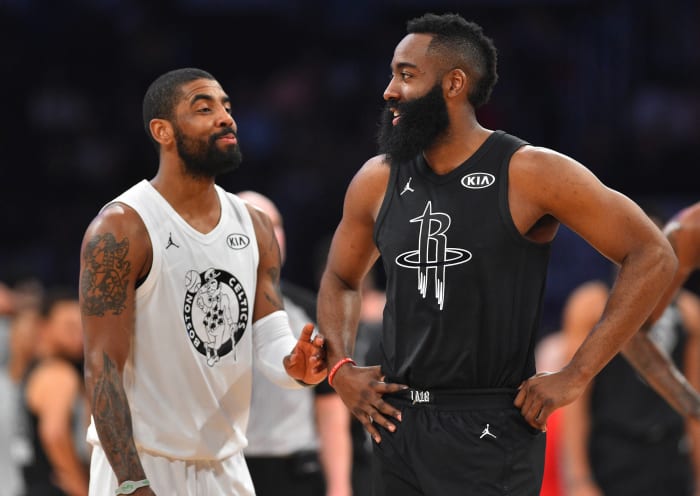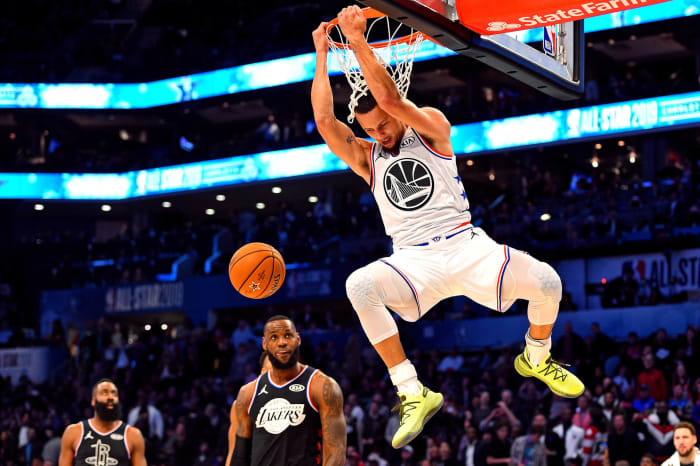NBA All-Star Games are as much fashion shows as they are competitive and meaningful exhibitions between squads attempting to proudly represent conferences. Every January, jersey leaks and official releases generate positive and negative reactions from social media users, fans and journalists. Those who collect memorabilia or just enjoy rocking fresh NBA gear may look more forward to the annual All-Star Game uniform release than the announcement of the names voted to start in the contest.
This wasn’t always the case. In the early 2000s, the Association had players wear standard club jerseys instead of uniforms designed specifically for Eastern and Western Conference All-Star teams. Fortunately, it seems that idea is nothing but a memory moving forward, as marketing gurus and jersey developers have learned that customers and fans are willing to spend on new NBA products each season.
We can’t help but wonder how far away we are from the rebirth of “retro” 1990s NBA All-Star uniforms.
NBA Photo Library/Getty Images
We won’t pretend too many of us were around when the first NBA All-Star Game took place in Boston in 1951, but we’re assuming fans didn’t rush to stores to buy jerseys worn during those contests. The short shorts remained part of basketball culture for decades (thanks for killing those off, Fab Five), and the lack of team names made these look more like warmups than actual uniforms. Never underestimate, though, how a good belt can complete a sports ensemble. If it’s good enough for baseball, it’s good enough for roundball.
2 of 25
1963: Los Angeles
NBA Photos/Getty Images
Some may say the 1960s was the best decade of the “Space Age,” so we’ll forgive the excess amount of stars on these All-Star jerseys. Besides, at least the fronts included the words “East” and “West,” so fans could tell which teams they were watching at a time when live NBA games weren’t broadcast in color on a nightly basis. Bill Russell won MVP for this contest played in Los Angeles.
NBA Archives
Now we’re getting to the good stuff. You may not even realize you’re thinking about an iconic photo featuring Kareem Abdul-Jabbar and Julius Erving when you recall the jerseys worn at the 1977 NBA All-Star Game. The colors pop nicely in photographs and video highlights, and there isn't an excessive amount of stars on the tops. These would look great during the 2020s.
Jerry Wachter/Getty Images
The 1980s began with NBA All-Star jerseys that more so belonged on a Major League Baseball diamond than on basketball courts. Blue and red made for nice color schemes, and the stars on either side of the tops would’ve been fine if not for those horizontal stripes that scream old-school Chicago White Sox. Remember, future uniform designers, that not all of us are thin enough to rock horizontal stripes placed on our sports merch.
Brian Drake/Getty Images
Less really is more in many cases, such as the All-Star jerseys the NBA presented to players and fans during the second half of the 1980s. You didn’t need binoculars to tell the teams apart. The words and numbers on the tops are bright and visible. Make the shorts longer, NBA, and you could bring these bad boys back for one year anytime.
Andrew D. Bernstein/Getty Images
Those of you capable of appreciating what the moment meant and were able to find them at the time can freely admit you owned Magic Johnson 1992 NBA All-Star Game jerseys. This is a safe space. Cursive often doesn’t work on sports apparel, but the writing existing underneath the number is legible, and the single star on the front is a nice touch. If you’re attending an All-Star Game, you’re probably going to see at least one of these over the weekend.
Andrew D. Bernstein/Getty Images
The ancient ESPN2 logo and jerseys from this NBA All-Star Game go synonymous with the second half of the 1990s. Graphic writing, a massive off-centered star that housed a cactus and bright colors all give an example of the types of jackets and other apparel many owned at the time. We suppose putting a sun inside of the star would’ve been too much of an on-the-nose way to offer a shoutout to that year’s All-Star host city.
8 of 25
1996: San Antonio
Noren Trotman/Getty Images
Those of you who miss the Vancouver Grizzlies but don’t want to represent Canada via your basketball merch can look for 1996 NBA All-Star Game jerseys. If the teal color on the East’s uniforms isn’t enough to sell you, perhaps the cartoon font and a chili spinning a basketball will convince you that these are the best, or maybe the worst, All-Star jerseys of that decade. For what it’s worth, the NBA ditched unique All-Star jerseys from 1997 through 2002. Look at what you did, San Antonio.
Andrew D. Bernstein/Getty Images
Remember when we told you the NBA could go back to the All-Star jerseys from 1985-90 at any time? That’s what happened when Michael Jordan played in the final ASG of his career in February 2003. The stars on either side of the jerseys take nothing away from the font and numbers. Those color combinations work for every season. These may be the GOAT ASG uniforms.
10 of 25
2004: Los Angeles
Andrew D. Bernstein/Getty Images
The NBA completed a 180 turn regarding All-Star Game jerseys in 2004, and, thus, it’s only fitting the Association hit the figurative wall. Unless we’re discussing hockey sweaters or maybe some soccer shirt sponsors, diagonal text on a jersey is almost always a poor choice. These ASG uniforms were made worse by designers placing small numbers over where pockets would exist on a shirt at a time when the phrase “high-definition television” meant little to the majority of Americans.
Nathaniel S. Butler/Getty Images
The 2005 NBA All-Star Game jerseys show that even billion-dollar companies can learn from mistakes, but these uniforms are the unseasoned potato salad of ASG gear. They’re fine. They’re not the worst of the bunch. You probably never want to see them again. Truth be told, the league could only improve in this department after 2004, or so we'd hope.
Jesse D. Garrabrant/Getty Images
Once again, we encounter the issue of horizontal stripes, this time two decades after the 1980s. Idea: Remove them, replace them with enlarged numbers and then relocate the stars to the sides. The shorts can stay to honor the era.
Nathaniel S. Butler/Getty Images
Just because one thinks outside the box doesn’t mean he has to set that box on fire. The 2007 NBA All-Star Game uniforms combined old and new, with classic colors and easy-to-read script. The digits on the fronts were perfectly placed and sized. The sides of the ensembles were loud but not deafening. You did well here, NBA.
14 of 25
2008: New Orleans
Andrew D. Bernstein/Getty Images
We understand it takes all kinds, and that one man’s trash is another man’s treasure. Let’s just put it this way: There are good reasons two-toned jerseys that alternate from front to back never became all that popular in professional sports leagues. We want to give the Association credit for the fancy writing on the front of the 2008 All-Star Game uniforms, but we’d rather just move on and forget this happened.
Nathaniel S. Butler/Getty Images
Once again, the NBA followed a swing-and-a-miss All-Star Game uniform with a completely inoffensive design. Different shades of red and blue mixed things up from prior years, and putting names underneath numbers on the backs set these jerseys apart from those worn on standard game days. If you had to pick between 2008 and 2009, there’d be no contest.
JEWEL SAMAD/AFP via Getty Images)
Those who loved cartoon chili peppers were probably bummed upon seeing designs for the jerseys worn at the 2010 All-Star Game played in Arlington, Texas. The Association embraced the “Lonestar State” mentality with the Eastern Conference uniforms that included the outline of a massive star. This game was played at AT&T Stadium, formerly Cowboys Stadium or “Jerry’s World,” so we guess we can let it slide. Everything is bigger in Texas, and we aren’t messing with that state.
17 of 25
2011: Los Angeles
Kevork Djansezian/Getty Images
Sometimes the difference between an “A” and “A+” comes down to a single word. The brightness of the 2011 NBA All-Star Game uniforms popped on TV, and the graphics on the front improved upon the designs from the prior season. We could’ve done without “The” hanging above both “East” and “West.” Eliminate that, and these are solid.
Garrett Ellwood/Getty Images
Opinions on the 2012 All-Star Game uniforms come down to if you prefer the shading over a single solid red or blue. If so, these are for you. Outside of that, there’s little spectacular or upsetting about these jerseys.
Ronald Martinez/Getty Images
The lack of horizontal stripes means these sit above the jerseys from the previous Houston All-Star Game in uniform power rankings. Red with blue trim and vice versa present a look you’d expect to see from the 1990s but with a 2013 twist. The NBA could utilize something similar during the 2020s without a problem.
20 of 25
2014: New Orleans
Nathaniel S. Butler/Getty Images
At the risk of hurting feelings: These are a no from us, dawg. We’re not sure if we dislike the sleeves or the “fleur-de-lis” logo more. At least New Orleans received a shot at redemption later in the decade.
Photo by Cem Ozdel/Anadolu Agency/Getty Image
The wheel doesn’t need to be reinvented. A massive number with no wording on the front of an NBA jersey looks weird. Adding the full names of players to uniforms creates the perception that fans don’t know the league’s stars. “Oh, Curry's first name is ‘Stephen?’ That’s pretty interesting.”
Bob Donnan-USA TODAY Sports
By wanting to honor the host nation of the 2016 All-Star Game, uniform designers accidentally gave us a cummerbund look. That’s our only complaint, as everything else about these is clean. Kobe Bryant made his last ASG appearance as an active player in Toronto.
23 of 25
2017: New Orleans
Bob Donnan-USA TODAY Sports
As Paul Lukas of Uni Watch pointed out, designers “probably had to scrap the Charlotte-based unis they’d been preparing and then scramble to create a pair of replacement designs” after the 2017 All-Star Game was relocated from Charlotte to New Orleans the previous summer. While we don’t want to be harsh due to the circumstances, UPI’s Alex Butler wasn’t wrong when he called these jerseys “bland” and “boring.” Marquez Anderson of Spurs Zone referred to them as “generic and forgettable.” We still think they’re better than the 2014 uniforms.
24 of 25
2018: Los Angeles
Bob Donnan-USA TODAY Sports
We give to you the start of the NBA All-Star Game monochromatic movement, one that, as Joel Beall of Golf Digest wrote, drew plenty of negative reaction from social media users. Per Ben Rohrbach of Yahoo Sports, not every Twitter personality immediately hated on the black-and-white schemes. We’re sure these would’ve looked swell back in the 1950s, but fans and consumers grew to expect more by 2018.
Bob Donnan-USA TODAY Sports
Instead of hating on yet another design you’d expect to see on a jersey resting on a discount rack at a low-end department store, we’ll simply point out those making All-Star Game uniform decisions went in a drastically different direction for 2020. Admitting your mistakes and moving on from miscues are a part of life.

 +
+


























